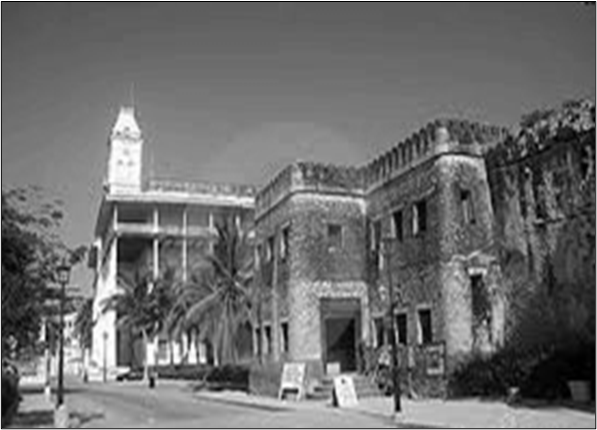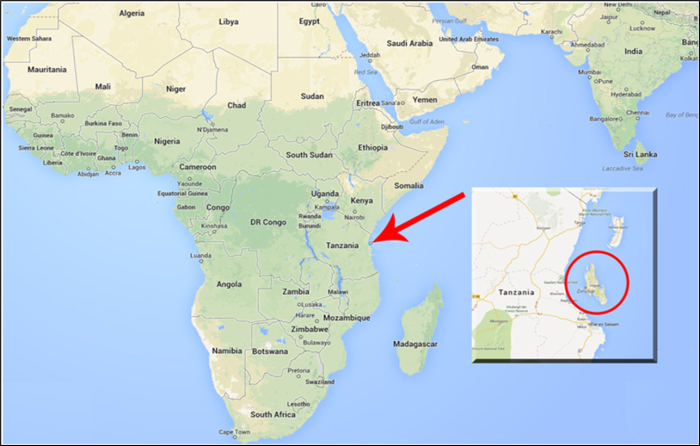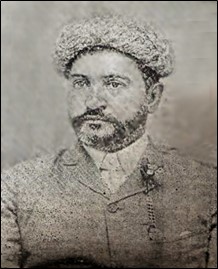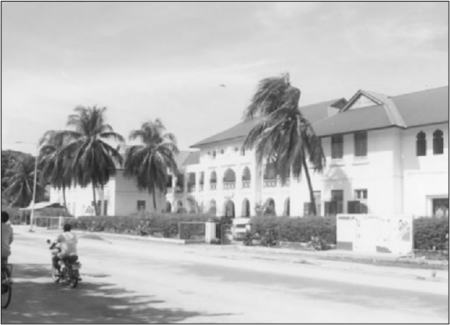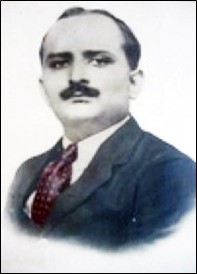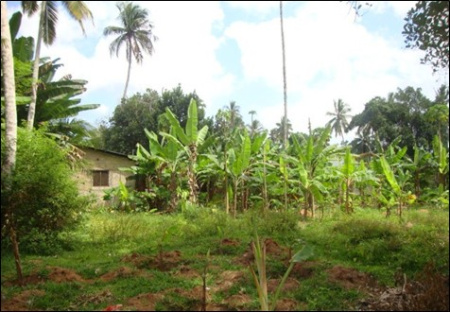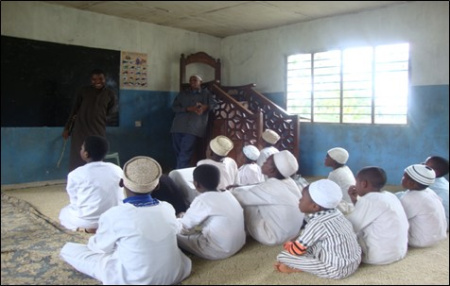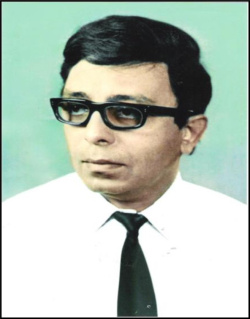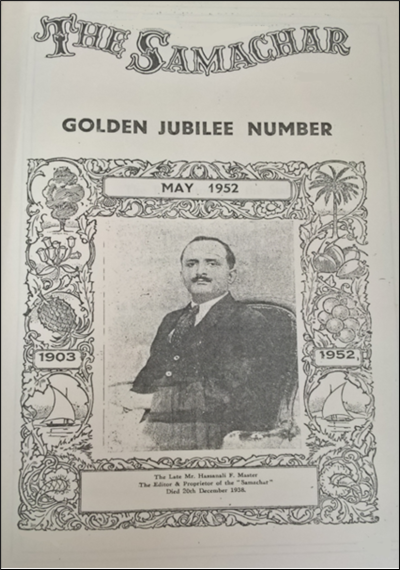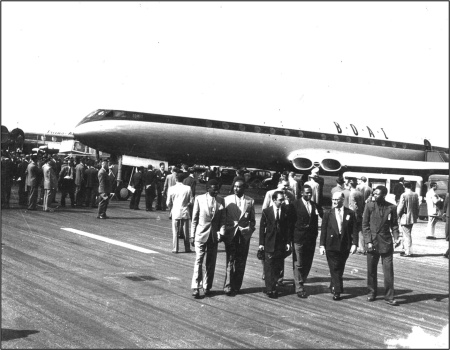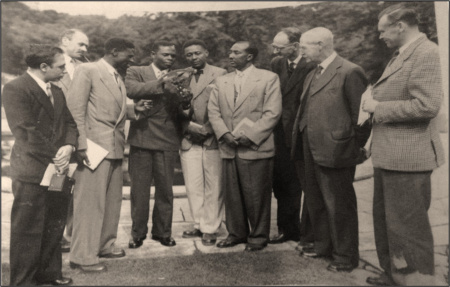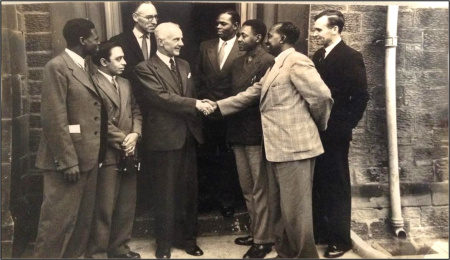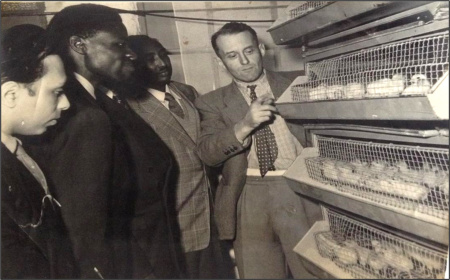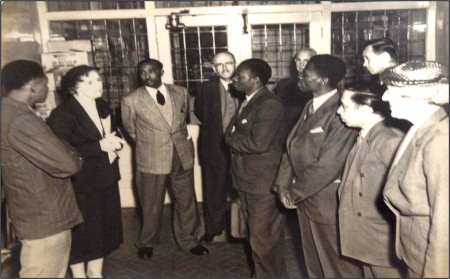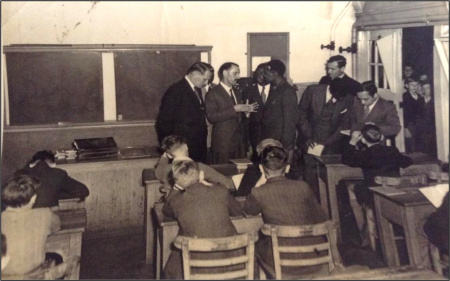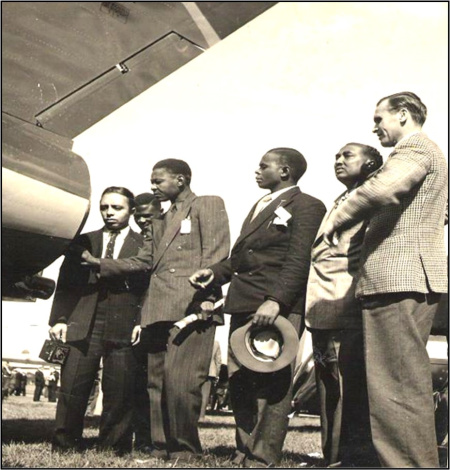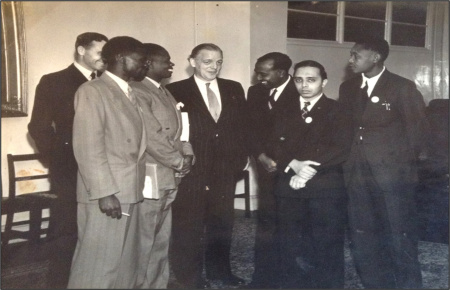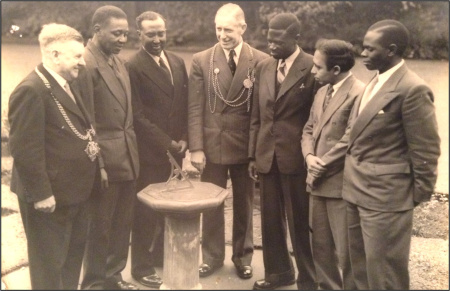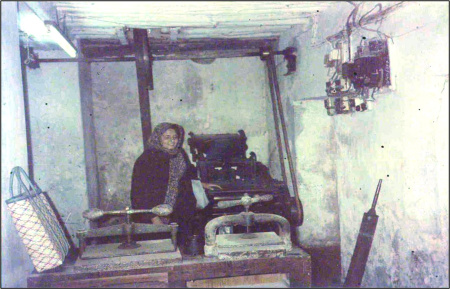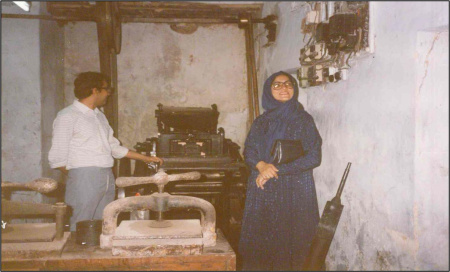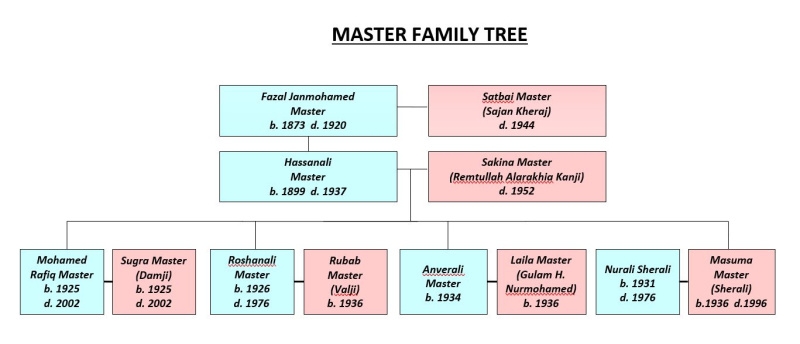Difference between revisions of "History of the Samachar 1901-1967"
Mohamedali (talk | contribs) (→Chapter 8. Family Tree) |
Mohamedali (talk | contribs) (→Chapter 8. Family Tree) |
||
| Line 432: | Line 432: | ||
<br> | <br> | ||
| − | [[File:History_of_Samachar_21.JPG| | + | [[File:History_of_Samachar_21.JPG|800 px|centre]] |
== References == | == References == | ||
Latest revision as of 13:24, 18 August 2022
Contents
- 1 Preface
- 1.1 Acknowledgments
- 1.2 Contents
- 1.3 Chapter 1. Early Zanzibar
- 1.4 Chapter 2. Fazal Janmohamed Master 1901-1920
- 1.5 Chapter 3. Hassanali Fazal Master 1920-1937
- 1.6 Chapter 4. Sat-bai Fazal Master 1939-1944
- 1.7 Chapter 5. Sakina-bai Hassanali Master 1944-1952
- 1.8 Chapter 6. Roshanali Master 1952-1967
- 1.9 Chapter 7. Historical Events in Zanzibar 1900-1984
- 1.10 Chapter 8. Family Tree
- 1.11 References
Preface
By Arif Roshanali Master (FBDO) e-mail: [email protected]
ISBN:978-0-9530123-5-0 / 1st edition: 8th July 2016
This book has been dedicated to the memory of my father, Marhum Roshanali Fazal Master. Please recite Surah Al–Fateha for all the departed souls. Any part of this book may be reproduced, stored in a retrieval system, or transmitted in any form or by any means, electronic, mechanical, photocopying, recording or otherwise but reprinting of the whole book will require the consent of the author.
Published by Iqra Publishers,Milton Keynes, UK. Tel: 01908 641392
Acknowledgments
I would like to express my gratitude to my family members who not only enabled me to do the research but, in fact, encouraged me to sit down and complete this endeavour. I would like to thank my wife, Sukaina, for helping me to type the book and my daughters Zainab and Fatema for their help in publishing. I would like to thank my mother, Rubab Master and my Uncle, Anverali Master who are the only senior members of the family living, with whom I was fortunate to corroborate some of the narratives. Equally, I would like to thank a number of people who have taken pains to read and comment on a series of draft versions of the text, or parts thereof, in particular, Dr Mahmood Datoo and Maqbul Rahim.
Also, I would like to express my gratitude to Fuad Mohamed of Zanzibar National Archive for his co-operation and assistance in granting me access to The Samachar newspapers during my visit to Zanzibar in August 2015. Furthermore, I would like to thank Sayyada Master for designing the cover page of this book. Finally, I would like to thank Lesley Spurrell, who did a great job as language editor. Any mistakes that remain in the text are due to my own oversights.
Contents
Chapter 1. Early Zanzibar
Chapter 2. Fazal Janmohamed Master 1901-1920
Chapter 3. Hassanali Fazal Master 1920-1937
Chapter 4. Sat-bai Fazal Master 1939-1944
Chapter 5. Sakina-bai Hassanali Master 1944-1952
Chapter 6. Roshanali Master 1952-1967
Chapter 7. Historical Events in Zanzibar 1900-1984
Chapter 8. Family Tree
References
Chapter 1. Early Zanzibar
Vasco da Gama's visit in 1499 marks the beginning of European influence in the island of Zanzibar, and the Portuguese established control over the island four years later. In August 1505, Zanzibar became part of the Portuguese Empire when Captain John (João) Homere, acting as part of Francisco de Almeida's fleet, captured the island and it was under Portuguese rule for almost two centuries. In 1698, Zanzibar became part of the overseas holdings of Oman, falling under the control of the Sultan of Oman. The Portuguese were expelled and a lucrative trade in slaves and ivory thrived, along with an expanding plantation economy centering on cloves. The Arabs established garrisons at Zanzibar, Pemba, and Kilwa. The height of Arab rule came during the reign of Sayyid Said, (Sayyid Said bin Sultan al-Busaid), who, in 1840, moved his capital from Muscat in Oman to Stone Town in Zanzibar. He established ruling Arab elite and encouraged the development of clove plantations, using the island's slave labour.
Zanzibar's commerce fell increasingly into the hands of traders from the Indian subcontinent; they were encouraged by Sayyid Said to settle on the island. For hundreds of years, natives traveled from India, their ship’s sails filled by the North Eastern Monsoon winds, taking their boats swiftly to the coast of East Africa. Amongst the traders arriving around 1840 were the Khojas from the areas of Kutch and Kathiawad in India. Their appearance along East African Coast is attributed to several developments back home. It is said that these parts of India were stricken with long years of famine and bubonic plague, and families lived below the subsistence level. Due to unemployment and scarcity of livelihood, many young men left these regions of India in search of new opportunities. After arriving in East Africa, a large percentage of these men converted from the Ismaili faith to Ithnasheri, and were novices in the complete sense of the word: new to the place, new to the faith, facing a vast unexplored tract of land, with no previous cultural contact with the indigenous African population, not knowing the African language and unable to communicate with the established Arab traders.
Wherever the Khojas settled, they soon formed themselves into a Khoja Shia Ithnasheri community, commonly known as the "Jamaat". They advised and assisted each other, and invited their families, friends and fellow men from India to join their venture. They engaged in religious activities, initially with the modesty appropriate to their means; but as their good fortune grew, they devoted more time and wealth to creating an infrastructure to support their faith and spread their beliefs. They built Mosques, Imambadas, Madaris, and Schools for secular education and created several charitable trusts. In fact, the Kuwwat Jamaat of Zanzibar became the first ever Khoja Shi'a Ithnasheri community "Jamaat" in the world, established in 1882. The Khojas elsewhere, including those in South Asia, were still facing opposition to establishing their own separate "Jamaat".
After the death of Sayyid Said, in 1856, his sons struggled over the succession. On 6th April, 1861, Zanzibar and Oman were divided into two separate principalities. Sayyid Majid bin Said Al-Said (1834/5–1870), his sixth son, became the Sultan of Zanzibar, while the third son, Sayyid Thuwaini bin Said al-Said, became the Sultan of Oman.The Sultan of Zanzibar controlled a substantial portion of the East African coast, known as Zanj, and trading routes extending much further across the continent, as far as the Congo River. However, from 1887 to 1892, all of these mainland possessions were lost to the colonial powers of the United Kingdom, Germany, and Italy. Zanzibar was famous worldwide for its spices and its slaves. It was East Africa's main slave-trading port, and, in the 19th century, as many as 50,000 slaves were passing through the slave markets of Zanzibar each year. David Livingstone estimated that 80,000 Africans died each year before ever reaching the island.
Tippu Tip or Tib (1837 – 14th June, 1905), whose real name was Hamad bin Muhammad bin Jumah bin Rajab bin Muhammad bin Sa‘īd al-Murghabī, was a Swahili-Zanzibari trader of mixed descent. He was famously known as Tippu Tib after an eye disease made him blind. A notorious slave trader, plantation owner and governor, who worked for a succession of Sultans of Zanzibar, he led many trading expeditions into East-Central Africa, involving the slave trade and ivory trade. He built up profitable trading posts reaching deep into Central Africa. Zanzibar's spices attracted ships from as far away as the United States, which established a consulate in 1837.
The United Kingdom's early interest in Zanzibar was motivated by both commerce and the determination to end the slave trade. In 1822, the British signed the first of a series of treaties with Sultan Said to curb this trade, although the sale of slaves did not become wholly prohibited until 1876. The control of Zanzibar came into the hands of the British Empire; part of the political impetus for this was the 19th-century movement for the abolition of the slave trade. The relationship between Britain and the nearest relevant colonial power, Germany, was formalised by the 1890 Heligoland-Zanzibar Treaty, in which Germany pledged not to interfere with British interests in insular Zanzibar. That year, Zanzibar became a British protectorate rather than a colony of Britain. From 1890 to 1913, traditional representatives were appointed to govern, switching to a system of British Residents, who were effectively governors from 1913 to 1963. Hamoud bin Mohammed, the son-in-law of Majid bin Said became Sultan with the support of the British consul, Sir Basil Cave, upon the death of Hamid bin Thuwaini. Before he could enter the palace, another potential contender for the throne, Khalid bin Barghash, son of Bargash bin Said seized the palace and he declared himself Sultan. The British responded the next day, 26th August, 1896, by issuing an ultimatum to Khalid and his entourage to evacuate the palace by 9:00 a.m. on 27th August 1896. When he refused, British warships fired on the palace and other strategic locations in the city, destroying them and causing Khalid and his group to flee.
According to the Guinness Book of World Records, the resultant Anglo-Zanzibar War was the shortest war in history, and on the same day, Hamoud was able to assume the title of Sultan, more indebted to the British than ever. Later, Hamoud complied with British demands that slavery be banned in Zanzibar and that all the slaves be freed. For this, he was decorated by Queen Victoria and his son and heir, Ali bin Hamud, was brought to England for further education. From 1913 until independence in 1963, the British appointed their own Residents, who were essentially acting governors. In 1963, however, the Sultanate regained its independence, from the United Kingdom, becoming a constitutional monarchy and a member of the British Commonwealth.
- The Old Fort in Stone town Zanzibar built by the Portuguese
- Map showing migration of Khojas from Kutch and Kathiawad areas of India, to the East African Coast
Chapter 2. Fazal Janmohamed Master 1901-1920
- The Late Fazal Janmohamed Master - Founder and Editor of The "Samachar" 1901 - 1920
The late Fazal Janmohamed Master, founder of The Samachar newspaper was born in 1873 in Hyderabad in Sind, India. The paper had a weekly circulation for the most part, though for short periods, The Samachar was produced daily. In 1890, Fazal, aged 17, came to Zanzibar and he was fortunate enough to get a job in the Customs under Mr Robertson who was in charge in the Customs. After serving for some time in this post, he joined Sir Euan Smith Madrasah as an assistant teacher and was so successful in the teaching profession that he was given the title Master, as "Master" in Gujarati means "good teacher". Since that time, "Master" became the surname synonymous not only to Fazal Janmohamed, but also to his entire family. Mr Yavarhusein was the Headmaster of the Madrasah at the time.
- The Primary School, Sir Euan Smith Madrasah (ESM), now Haile Selassie School
All this happened within five years. But Fazal was not satisfied with the work he was doing, either in the Customs or in the school. His abilities, along with his irrepressible interest in, and passion for, journalism, awaited a suitable opportunity that might offer an opening for his activities in this direction. At last, in 1895, he bought a press in partnership with Mr Saleh Chagpar, a prominent member of the Khoja Ithnasheri Community of Zanzibar and some other influential gentlemen. Sadly the press did not remain in their hands for very long. After some time, it had to be sold and it was bought by Messrs Esmailjee Jivanjee & Co who called it Taibi Press. They too disposed of it after a while, one assumes for economic reasons. But during the short time that the press was in the hands of the first partners, Fazal got his first lessons in the art of printing, under the guidance of Mr Saleh Chagpar. The printing press, therefore had served a very useful purpose. At the time, there was a newspaper published in Zanzibar called Zanzibar Akbar. Fazal, who liked nothing better than a press and a newspaper, tried his best to regain a press of his own and to start his very own newspaper. However, it was a difficult prospect for a person of meagre financial resources like Fazal, but fortune smiled on him. Seeing his zeal, Messrs Valabhdas Kalyanji and Gokaldas Hansraj came forward and undertook to provide him with a printing press. Fazal's joy knew no bounds. The press was set up and he was able to start his own newspaper after all. He called it the Islam Samachar, the first issue of which appeared on 28th July 1901. His ambition was thus crowned with success and one can imagine the pride and satisfaction he must have felt when he handled this first issue of his own newspaper. Later on, he was constantly helped by Messers. Karimjee Jivanjee & Co, in acquiring printing plates and other materials.
Mr. Yusufali A. Karimjee Jivanjee, especially, always used to help Fazal, not only through his company but also in a personal capacity. The help of Mr. Jivanjee and his firm was noteworthy and essential in Fazal’s future career. The newspaper continued to 30th July 1903 as a purely Gujarati language newspaper. From August 1903, the newspaper was called Zanzibar Samachar and so the name "Samachar" first came to be coupled with the newspaper. It carried on up to 30th July 1906 as a newspaper with a weekly circulation. From August 1906, however, Fazal changed The Samachar to a daily newspaper and it went on as a daily for two more years. Circumstances, however, were not favourable for a daily newspaper and Fazal also failed in his attempts to have some English columns incorporated therein. So on 1st November 1908, it was again changed to a weekly newspaper and went on until October 1911, completing ten years of its existence by that time. After running thus for ten years, the newspaper had to be stopped for some time, as Fazal wanted to go to India for a vacation. On his return to Zanzibar, he resumed publishing the newspaper, but under the name of El Islam & Samachar. It continued initially as a daily, and then, subsequently as a weekly publication for two years.However, a time came when Fazal could no longer get sufficient printing work to carry on his Press. At that time, there were four printing presses in Zanzibar; The Union, The Meher, The Najah and The De Lord Press. In addition to these, the Government Press also used to accept private work in those days. The market for printing work was thus divided between five companies, not counting his own press; whilst he recognised that there was not enough work, he was never discouraged. This was his greatest characteristic and quality. He never admitted to, or accepted, being beaten. Instead, he decided to take his business to Mombasa at the end of 1913 and, when he was settled there, he re-established his newspaper in Mombasa, calling it The East Africa Samachar. It was a daily newspaper and the first issue appeared on 29th January 1914. His Press and his newspaper flourished. But his restless nature would not allow him to be content. He went on a marketing trip as far as Uganda and secured many orders for printing work and also subscribers for his newspaper. He successfully acquired customers as far afield as Mwanza and Bukoba in Tanganyika. The business began to expand wonderfully, but then another blow came.
The First World War began in 1914. Fazal lost much of his business. Times changed and Fazal found himself in difficulty once again, but his resourcefulness, as before came to his rescue. He started publishing a daily Gujarati translation of Reuter's cables and as the war was in progress, he got many subscribers, which kept his business going. At this point, unfortunately, the wartime regime of Martial Law was introduced in Mombasa. Fazal saw that the wisest thing to do at this stage was to stop his newspaper altogether, as the whole political atmosphere was too uncertain for a newspaper like his to continue. With the discontinuation of the newspaper, however, Fazal also lost his means of livelihood and maintenance. But he was not a man to brood over his difficulties, however great and crushing. He searched around for some other means of livelihood, any means to enable him to earn his daily bread in those hard times. He managed to acquire a sewing machine and transformed himself into a tailor. He was never beaten - a great gift indeed. In this way, he managed to out his existence until he was able to return to his beloved Zanzibar. This became possible in the year 1916. In that year, he made Zanzibar his headquarters and brought his press back home. Fortune smiled again on his indomitable courage. Orders for printing work began to pour in. Once more he could indulge in his favourite luxury of producing a newspaper of his own. In the fifteenth year of his career as a journalist, Fazal started another newspaper; this time called simply, The Samachar and the first issue appeared in Zanzibar on 1st May 1917. The issue was known as the 15th Volume of the newspaper, since the period of several vicissitudes that the newspaper had faced to that point, described above came to 14 years, thus The Samachar came into circulation again in Zanzibar as a weekly edition. It was still, at that time, a purely Gujarati based newspaper. Fazal, once again tried to introduce English columns, but was unsuccessful and so The Samachar continued to be a newspaper containing Gujrati columns only.
Nevertheless, the newspaper was published regularly, the press received regular work orders and Fazal was thus free from his financial anxieties. He could now devote his attention to his main work compared with previous circumstances up to that time. It had always been his ambition to make his newspaper an uplifting power for good, for public welfare and as a positive and inspiring influence for the population in general; with of course particular attention to Islamic matters and, more specifically, to those relating to the community he belonged to, namely the Khoja Ithnasheri community of East Africa, especially of Zanzibar. Public grievances without distinction of class or creed always found a strong supporter in The Samachar and Fazal never let go of an opportunity to bring them to the attention of the authorities concerned. He was an inveterate foe of injustice and was always the first to expose instances of injustice in any shape or form in the columns of The Samachar and the old files bear ample testimony to this trait of his character. Indeed, as is very often the case, Fazal had to suffer much for his temerity in such matters. But throughout his life, he had always been a fighter in the cause of justice and a campaigner for fair plays all rounds. It would not be out of place if we give here a few instances of Fazal’s intrepid nature in this respect, though we have to go back a little in time to do so. During the time of the war between Turkey and Italy during the year 1912, he was a joint Secretary of the local Red Crescent society. While in this capacity, he was once threatened with deportation from Zanzibar. Regardless of any ramifications, he continued discharging what he considered to be his duty towards Islam and towards his own community and towards the general population of Zanzibar and East Africa.
Once during Muharram, he wrote a series of articles in connection with the attitude of the local Ismailia Council towards those members of the Ismailia community who used to attend the "majalis" of Imam Husein (A). These articles led to a very big libel case in Zanzibar. The first case was filed against Fazal, as editor of The Samachar by Mr. Saleh Vali Dharsi, who was then the President of the Ismailia Council and then two or three other similar cases were also filed against Mr. Master. One of these was by Mr. Reece, Bar-at-Law and the other by a Hindu gentleman. In these two cases, Fazal was even committed to the court sessions though both these cases were withdrawn later on. In the case, instituted by the Ismailia Council, the Magistrate’s Court sentenced Mr. Master to 4 months in prison and a fine of Rs 750.00. Fazal became an inmate of His Majesty's Jail in Zanzibar on that occasion for one afternoon, being released on the same day. When an appeal was filed, Judge Murison His Honour from the High Court heard the appeal and gave a very careful, learned, and exhaustive judgement. In this judgement, His Honour reproduced all the leading articles of The Samachar which were alleged to be defamatory and he stated that he could not see anything libellous in any of them except the use of the word "uneducated" in one place with respect to Mr. Saleh Vali Dharsi for which his Honour said a fine of Rs 10.00 was quite enough. When the case was thus concluded and Fazal was released, and unpunished, except for the fine of Rs 10.00 he was greeted with great joy by the members of the Khoja Ithnasheri community. The judgement is a very famous one and was published in the law reports of Zanzibar, at that time, and also in the Official Gazette.
Fazal’s unique quality was that even when the prospects seemed bleakest, while these cases were being heard, Fazal himself was never down-hearted and he was always happier and more optimistic than his friends and sympathisers. But as mentioned previously, he was known to have been like that since his childhood. His physical courage and fearlessness of heart had always been greater than that of the average person. He was never perturbed, either when it seemed as if the cases were going against him, with the prospect of a long term of imprisonment ahead, or when he got no work for the press and even when he had to close it, as happened when he was in Mombasa during the war when martial law was declared. As described before, he even turned himself into a tailor but never blamed fate or luck for his misfortunes, but he always faced every difficulty and challenge with courage and somehow or other he always found a way out of testing situations. Had it not been for this trait in his character, his favourite newspaper The Samachar would have ceased to appear a long time before. The Samachar had now humbly been playing its part in Zanzibar and mainland Tanganyika for over a quarter of a century, generally educating, informing, and raising the spirits of the people of these provinces, and especially the Indians. During these 25 years, several other Indian newspapers appeared and then closed after only a short period of publication in Zanzibar, as well as on the mainland. This is not to blame anybody or to deprecate the attempts of those other gentlemen who started newspapers but purely to emphasise the said trait of Fazal's character. Had it not been for his indomitable will and purpose, The Samachar would also have gone under, not once but several times before this. It was Fazal's newspaper and as he was not a man to ever give up, it is no wonder that his newspaper The Samachar also endured, and was imbued with the same characteristic.
We now come to the close of Fazal's eventful career. After leading a strenuous and demanding life for about a quarter of a century, and after being assured that his favourite Samachar was firmly established, Fazal finally decided to perform important religious duty. He made a decision to go on a pilgrimage to Kerbala in Iraq. His whole life had been full of ups and downs until this point but he knew now he could safely go on pilgrimage without jeopardising the position of his newspaper. He had by this time also trained his adopted son, Mr. Hassanali F Master, as the next Proprietor of The Samachar, and was confident in his abilities. Hassanali was the biological son of Bhan-bai Walji Bhojani, sister to his wife Sat-bai and Fazal’s own nephew by marriage. As he had not been to India for a long time, Fazal decided to visit India first and visit his native birthplace Kutch and then proceed to Iraq. So he and his wife Sat-bai left Zanzibar on 12th July 1920 by B.I. boat S.S Karapara. After landing at Bombay, Fazal took the train to Kutch Bhuj with the intention of visiting his father's birthplace. Unfortunately, his last wish was denied to him. Fazal on reaching Jamnagar in Kathiawar, on his way to Kutch, had a heart attack and tragically succumbed to this fatal attack, breathing his last breath in Jamnagar at 9 pm on 18th August 1920 at the age of 48.
Chapter 3. Hassanali Fazal Master 1920-1937
- The Late Hassanali Fazal Master - Editor of The "Samachar" 1920 - 1937
Hassanali was a man of great intellect and at the time of the death of his father in August 1920, the founder of The Samachar, he was then in his early teens. Nonetheless, he very readily shouldered the burden that had fallen upon him when he could hardly carry it. Prodigious could well describe the latent talents he displayed for he immediately set himself to support and take care of his mother Sat-bai whose unfortunate position cannot be imagined. She had to return to Zanzibar without her life's companion, who was parted from her by his sudden death and as a result, neither were able to go to sacred Kerbala.
Hassanali was overwhelmed by this blow for a time. But he had been trained by his father not only in journalism but also in the intrepid way in which Fazal had looked upon life throughout his career. Hassanali took charge of the business and The Samachar and among the steps taken by Hassanali to improve his newspaper was the permanent introduction of English columns from 13th August 1922, enlargement of the newspaper's size, and the increase in the number of pages. He was able to improve his newspaper considerably and by this time it had become the most popular and widely circulated Anglo Vernacular newspaper published in East Africa. After the late Mr. P.B. Khare, who was his assistant editor, had retired, Mr. Mohamadali A. Rahim acted as Assistant Editor. From 1922 onwards, due to his keen interest in journalism, Hassanali made every attempt to improve his newspaper and, day by day, the newspaper became popular throughout East Africa and circulation began to increase. By this time the newspaper had been established on a firm footing and therefore Hassanali did not encounter any trouble as his father Fazal had confronted during the early career of this newspaper. With the issue of 24th April 1927, The Samachar completed its 25th year. It had been the intention of Hassanali since the completion of the 25th year to publish a Special Silver Jubilee edition of The Samachar and this edition was published in 1928. Although this number should have been out on 1st May 1927 it was nearly one and a half years late due to reasons beyond his control. In the first place the seriousness of this work was underestimated and in the second place, Hassanali had to work almost single-handedly in collecting together all the materials that formed that edition. Generally, such work would be undertaken only when there were sufficient hands to carry out the work which could then be conveniently divided among them. In this case however, Hassanali was the architect who made the plans, the carpenter who prepared the woodwork and also the labourer who collected the material for this edition. To complicate matters further, Hassanali confronted other unexpected difficulties as well. Thus, single-handedly, Hassanali was able to publish the Silver Jubilee edition, someone and a half years after The Samachar completed its 25th year of existence. The edition sold well with many subscribers and Hassanali received several letters of appreciation and congratulations.
During his lifetime, Hassanali purchased some farmland in Mwera, Darajani where there were many coconuts, cloves, and exotic fruit trees which brought income to the family, then and in the future. The farmland in Mwera still exists today and is now used for charitable purposes, with a Madrasah built to teach children religious and educational studies. This charitable project was inspired by Rubab Master who was very keen to see the provision of teaching and learning, especially of religious education. There are future plans to expand on this charitable work in different forms, in the memory of Hassanali Master and all dear departed souls. After working extremely hard from 1927, determined to improve his newspaper, and to increase its popularity, Hassanali decided to go to Kerbala in Iraq and set out on this sacred pilgrimage together with his family and his elderly mother.
- The Farmland "Shamba" in Mwera, Zanzibar
- Local Children learning Religious Education in Madrasah at Mwera, Zanzibar
It was particularly poignant for him to take his mother, as she had been unable to go and complete the sacred journey in 1920, due to the sudden death of Fazal – her husband.
Hassanali left Zanzibar with his family in 1933 and set out for Kerbala, leaving the editorship of his newspaper in the capable hands of Mr. P.B. Khare, who had vast experience in journalism. After nearly six months’ absence, Hassanali returned to Zanzibar and took over the chief editorship of the newspaper relieving Mr. P.B. Khare, who then acted as Assistant Editor. After some time, Mr. Khare retired and left for India, where he died on 27th May 1941, three years later. Though Hassanali thoroughly reorganised and modernised the business he had inherited from his father, ironing out the creases, he never deviated from the vision that the newspaper’s founder had mapped out for him. Although, due to unavoidable circumstances, he had been forced to leave school at a very early age, after only completing his primary level education, he successfully mastered the English language, through experience, and his editorials carried great weight and influence throughout East Africa. A few years after taking complete control of his newspaper, Hassanali became very popular among all sections of the community due to his genial temperament. Besides acting as Chief Editor for the English section, he also acted as Editor for the Gujarati section.
In December 1936, Zanzibar celebrated the Silver Jubilee of His Highness the Sultan with great enthusiasm and éclat. Hassanali had succeeded in his desire to increase the popularity of his newspaper, and, with preparations made well in advance, he made the decision to publish an exclusive Silver Jubilee Issue, celebrating the 25th year of the reign of His Highness, the Sultan, Sayyid Sir Khalifa bin Harub. From August 1936, Hassanali, supported by Mr. Mohamedali A. Rahim as his assistant editor, made an all-out effort to publish the Silver Jubilee edition of the official day of celebration. His efforts were rewarded and he succeeded in his ambition. The edition was circulated on Sunday 27th December 1936. The issue contained over 130 pictures, including more than 60 of Zanzibar and Pemba views; historical photographs of His Highness, the Sultan's life; his visit to England, and views of historical places of His Highness' dominions and their staple industries. It also contained interesting articles regarding the History of Zanzibar; twenty-five years of His Highness’ reign and other fascinating items, written by prominent people. Hassanali received several letters of commendation and congratulations on publishing this edition. His Highness the Sultan was especially pleased to see the Silver Jubilee edition of The Samachar and he conferred upon Hassanali a Jubilee Medal for publishing such a special tribute in his honour. Encouraged by a very positive response to the Silver Jubilee edition from the public, Hassanali decided to publish a Coronation edition to celebrate the Coronation of His Late Majesty, King George VI, and Queen Elizabeth and this edition appeared on Tuesday 11th May 1937. The edition, which was printed on art newspaper, contained illustrations depicting the life of the late King George; Her Majesty the Queen, and the royal family. Some 4000 copies were sold in two days and Hassanali received numerous letters of congratulations as only The Samachar published a special edition on this occasion.
On the night of Monday 19th December 1937, Hassanali died suddenly due to heart failure and, with his untimely and most tragic death, this journal was deprived of its great architect and chief editor. His sudden death evoked sincere sympathies from all quarters in Zanzibar as well as from all neighboring territories. No greater tribute could be paid to the deceased in the realm of journalism than the one that came personally from His Excellency Sir J. Hathorn Hall, who was the British Resident of Zanzibar at that time. In his letter of condolence, His Excellency was pleased to observe that he profoundly regretted to learn of the untimely death of the talented editor of The "Samachar". After expressing deep sympathy for the family, he added that Hassanali would be very greatly missed in the realm of journalism and public affairs. His Excellency was aggrieved to think that the country was deprived of Hassanali’s wise and impartial observations. This tribute, coming as it did from the head of administration in Zanzibar, speaks volumes. Tributes in a similar streak were contained in numerous letters of sympathy received by Hassanali’s family on their great loss. Hassanali Master had envisioned vastly improving the newspaper and its tone, but unfortunately, his life was cut short before all of his plans could be brought into effect. He died and was buried, in Zanzibar, his birthplace leaving behind three young sons aged 4, 8, and 10, one daughter aged 3, a widow, and his elderly mother, whose tragic loss defies description and is left for readers to imagine.
Chapter 4. Sat-bai Fazal Master 1939-1944
Sat-bai’s old age, coupled with many strenuous years, had made her very tired and at this time she required complete rest. However, due to the burden has fallen upon her, she boldly decided to take over the control of the newspaper. Therefore, from 1st January 1939, the newspaper was published under her name. The whole of her life experience had been full of ups and downs. At a time when she should have been enjoying a quiet retirement under the care of her family, she courageously chose to honour the work of her husband, and subsequently her son, taking on the onerous responsibility for The Samachar. Sat-bai had complete faith in God and in submitting to the will of the Almighty, she overcame the tragic blow of losing her son at the relatively young age of 38. Due to her past experience, when, it is said, she used to help her husband, the founder of this newspaper, in every way, Sat-bai was able to continue to publish the newspaper. She achieved this with the invaluable assistance of Mr Kashiram Khimdas, who, at the time of Hassanali’s death, was the Head compositor. Had this committed and honourable lady not taken on the full responsibility for this newspaper, then it would have ceased publication. She appointed Mr Kashiram Khimdas as manager of The Samachar, while Mr. Mohamedali A. Rahim who was then acting as Assistant Editor, became the Chief Editor of The Samachar. We have nothing but praise for these two gentlemen who worked faithfully with Mrs. Master to her entire satisfaction. In September 1939, World War II broke out, and, as the war spread, the shortage of newspapers, as well as materials, began to be felt. The Samachar newspaper was not spared from its disastrous and far-reaching effects. As the war continued, the scarcity of paper and essential printing materials forced Sat-bai, Proprietor-in-chief, to reduce the size of the newspaper from 24 pages to 18 pages and as supplies became even more acute, the paper was reduced further, to a mere 12 pages. However, mention must be made that in spite of this sudden reduction in page numbers, the popularity of this newspaper remained as great as it had ever been. Due to the continued strenuous efforts of the late Hassanali, the newspaper had, by then, been recognised as the most influential Ango-Vernacular newspaper in the whole of East Africa. Aside from the shortage of paper and printing materials, The Samachar had to suffer another difficulty on account of the war. The war greatly hampered trade and, as a result, many firms, both local and overseas, were forced to suspend their advertising campaigns. The valuable revenue and lifeblood of the newspaper, which had been generated by such regularly placed advertisements, was suddenly withdrawn and the newspaper was at risk of being suspended. A newspaper depends mainly upon advertisements and if this source of income is removed, any publication would find it very difficult to go on publishing. However, in spite of this setback, The Samachar soldiered on and was able to uphold its tradition with not a single week passing, during the war, when the newspaper was not published. On 17th August 1944, Sat-bai, who since the death of Hassanali F. Master had taken over the control of the newspaper, died suddenly and was buried in Zanzibar. With her death, The Samachar was deprived of yet another of its chief architects.
Chapter 5. Sakina-bai Hassanali Master 1944-1952
At the time of Sat-bai’s death, Hassanali’s sons, Mohamed Rafik, Roshanali, and Anverali, were still in full-time education. Therefore, the whole responsibility fell upon their mother Sakina-bai to take control of the newspaper, just as Sat-bai had done, after the death of her son, Hassanali. Sakina-bai shouldered the responsibility with great courage, assisted by Mr Kashiram Khimdas and Mr Mohamedali A. Rahim. Unfortunately, very little is known about her, that can be corroborated from the annals of history. However, a few details that are known include the fact that she had a sister by the name of Zainab (Jenna Bai) Remtulla Alarakhia Kanji, who was married to Rashid Manek (Bapa Rashid). She also had a brother, Abdulhussain Remtulla Alarakhia (Bha Bachu), who resided in Mombasa, Kenya in the later years and died there. In 1945 the war came to an end and an era of peace dawned. Trade began to expand, and the economy improved, with the result that the advertisements which had been withdrawn during the war started re-appearing. At the same time, the circulation of the newspaper began to increase, owing to the great popularity the newspaper had achieved in India and Pakistan after the partition. From 1945, The Samachar continued to make progress and after a long and chequered history, entered its fifty-first year of its existence.
On the morning of Friday 28th March 1952, Mrs. Hassanali Fazal Master (Sakina-bai Remtulla Alarakhia Kanji), who was acting as Chief Proprietor of The Samachar, died after a short illness and was buried in Zanzibar. With her death, the newspaper was once again deprived of yet another wise and experienced architect. Sakina-bai took control of the newspaper after the death of her mother-in-law, Sat-bai, widow of the late Fazal. She did her utmost to accomplish the task left unfinished by her husband for the improvement of the newspaper. She was very close to completing his vision for the newspaper when she died. It was her wish to publish the Golden Jubilee issue following which she wished to retire, handing over the entire management of the newspaper to her sons. It was then her intention to visit Holy places in Iran and Iraq for pilgrimage, a journey which every devout follower of Ahlulbayt performs at least once during their lifetime. It is regretful that she left this world without accomplishing her final task but her name and legacy will remain forever in the history of this newspaper. It is extremely sad that she was not able to see the special edition published as well as being unable to fulfill her ambition to visit the Holy places in Iran and Iraq.
Chapter 6. Roshanali Master 1952-1967
- The Late Roshanali Master - Editor of The "Samachar" 1952 - 1967
Roshanali, the second child of Hassanali and Sakina-bai was born in Gisenga Street, Zanzibar on 25th May 1926. After the death of his mother, Sakina-bai, Mohamed Rafik, her eldest son, briefly took over the management of the press and the editorship of The Samachar. But due to his ill health, shortly after, he passed on the editorship to his younger brother Roshanali. Even though Roshanali was the real Editor of The Samachar, he chose the newspaper to circulate under the name of his older brother, Mohamed Rafik Master. At this point, due mainly to the dedicated efforts of their father, Hassanali, The Samachar was the most widely circulated, most popular, and the most influential Anglo-Vernacular weekly newspaper in East Africa. During his time as editor, Roshanali endeavored to re-modernise the printing press by replacing the old metal types with a semi-automatic Heidelberg Machine. The Golden Jubilee issue of The Samachar was issued in May 1952 in sacred memory of Mr. and Mrs. Fazal Master and Mr. and Mrs. Hassanali Master. Today, it can still be found on display in the Zanzibar National Archive.
Some of the historical and literary material appearing in the Golden jubilee was taken from The Samachar Silver Jubilee, published in 1929, as well as from The Samachar Special Silver Jubilee issue published in 1936. In August 1954, amongst a party of Central and East African teachers and journalists, Roshanali, as editor of The Samachar, was invited by the British Government on a month long tour of England. This included visits to many places of interest including the Houses of Parliament at Westminster, British Broadcasting Corporation House, car factories, cotton mills, and steel works. The delegates were also taken to hydro-electric stations, farms, schools, welfare centres, and they were even invited to the official launching of a 16,000-ton British tanker.
In his memoirs of Zanzibar, Mr. Abdul Razak Fazal writes that "Once, in December 1959 when I was at my aunt's place, I had the privilege of accompanying the late Roshanali Master, to watch a match between Zanzibar and Kenya at the Khalifa ground. He held a special pass and we were made to sit in the VIP section just behind the British Resident and the Sultan's family members. Zanzibar's Majham and Boti displayed thrilling football but eventually, Kenya prevailed. Elijah Lidonde, Kenya’s star footballer, scored twice to beat Zanzibar 2-1." On 10th December 1963, Zanzibar gained its independence from the United Kingdom as a constitutional monarchy under the Sultan. This state of affairs was short-lived, as the Sultan and the democratically elected government were overthrown on 12th January 1964 in the Zanzibar Revolution led by John Okello. Okello was a Ugandan citizen who invaded Zanzibar with British trained Ugandan soldiers from the mainland. Sheikh Abeid Amani Karume was named president of the newly created People's Republic of Zanzibar and Pemba. An estimate of between 5,000-12,000 Zanzibaris, an ethnic minority of Arabic descent and Indian civilians, were murdered and thousands more detained or expelled and their property confiscated. The Samachar newspaper continued publishing until August 1967 when it was confiscated by the army. The Proprietor of The Samachar, Roshanali, was then invited by the revolutionary Council of Zanzibar to run the press, under the watchful eye of the Zanzibar army. He refused the offer and was taken by the army and imprisoned, thereafter a personal plea was asked for his release from his wife Rubab Master, his younger brother Anverali, and a prominent member of the Shia Ithnasheri jamaat, Mustafa Rajabali who was working in the police department. After meeting with Sheikh Abeid Amani Karume, they successfully secured Roshanali’s release upon which he immediately fled to safety on mainland Dar es Salaam. Regrettably, the Samachar ceased publication after his departure. The press remained in the hands of the army and some small printing work continued until the machines were decommissioned.
The revolutionary government nationalised the local operations of the two foreign banks in Zanzibar, Standard Bank, and National Grindlays Bank. These nationalised operations may have provided the foundation for the newly created People’s Bank of Zanzibar. Jetha Lila, the one locally owned bank in Zanzibar, closed. It was owned by Indians and although the revolutionary government of Zanzibar urged it to continue functioning, the loss of its customer base, as Indians left the island, made it impossible for the bank to continue. The Indian community, which had hitherto dominated the most important business branches, left the island, and, as a consequence, the Asian papers disappeared. Thus, the Revolutionary Government’s monopoly on the Zanzibar press began. This led, ultimately, to the demise of all the political press. The colonial Information Office was replaced with the Zanzibar Information and Broadcasting Services (ZIBS) shortly after the revolution. Following the guidelines of the Arusha Declaration, the government started to nationalise the most important economic sectors in 1968.
On 26th April 1964, the mainland colony of Tanganyika united with Zanzibar to form the United Republic of Tanganyika and Zanzibar; this lengthy name was condensed to The United Republic of Tanzania, on 29th October 1964. After unification, local affairs were controlled by President Sheikh Abeid Amani Karume, while foreign affairs were handled by the United Republic in Dar es Salaam. Zanzibar remains a semi-autonomous region of Tanzania. After fleeing from Zanzibar in 1967, Roshanali started working for a Norwegian printing supply company, Thoresen & Co. Ltd in India Street, Dar es Salaam. A few years later, he opened his own stationery and book shop called Husaini Stationers. In late 1975, he suffered a major heart attack. Sadly, he passed away on 16th December 1976 in London at St Thomas’ Hospital at the age of 50, after an unsuccessful heart bypass operation. He was buried in Dar es Salaam, leaving behind his wife Rubab, two daughters, Fatima and Fehmida and three sons, Mussadiq, Arif and Murtaza.
- Copy of the Golden Jubilee issue of The Samachar – May 1952
- Roshanali Master, Editor of The Samachar, with other delegates from East and Central Africa arriving in London on 28th August 1954
- A party from Central and East Africa inspects a model in Glasgow during their tour of the North East of England. Roshanali Master is on the far left
- Visit to Gosforth Urban district council offices, near Newcastle upon Tyne. The party is being received by the chairman of the Council, Councillor J.L. Robinson; standing behind is the clerk of the Council Mr C.S. Perkins
- This photograph shows members of the party inspecting the turkeys in their heated cages. They were shown around by Mr Chalmers Watson
- The welfare officer of the Welfare Centre in Gosforth describes the work of the department to the party of visitors from Central and East Africa
The headmaster of Gosforth Modern School for boys, Mr T.L Matthews, explains the work of the school to a party of visitors from Central and East Africa. Roshanali Master, editor of The Samachar, is on the far right of the picture
- Visitors from East and Central Africa talking with the pilot of the helicopter
- The Rt. Hon. The Earl of Munster, Parliamentary Under-Secretary of State, met Journalists from Central & E. Africa at a reception held at the Colonial office in London
- The Sheriff of Newcastle Upon Tyne, Alderman H. Waller meeting party of East and Central Africans in the garden of Mansion House, Newcastle Upon Tyne
- Rubab Roshanali Master visiting The Samachar Press in the 80’s when it was run by the Zanzibar army
- Hasan Mohamed-Rafik Master and his wife Rehana visiting The Samachar Press in the 80’s
Chapter 7. Historical Events in Zanzibar 1900-1984
January 1901
Tea: the first packet of tea made in East Africa was packed in Dunga, Zanzibar. The leaves were the first products of the garden that was laid out there in 1899. It was manufactured with such appliances as were to hand, rolled on the deal table, sun-dried, and fired with an ordinary charcoal stove.
28th July 1901
The first newspaper in Zanzibar Islam Samachar was issued on 28th July 1901. It was then a purely Gujarati newspaper. In August 1903, the newspaper was called Zanzibar Samachar. Later on, several papers were issued in Zanzibar.
August 1901
The first bulk oil installation started in Zanzibar following the completion of a tank and pier at Mtakuja. The tank for receiving petroleum in bulk was erected by Messrs. Smith Mackenzie and Co. the Agent for Shell Transport and Trading Company Limited. The installation was most comprehensive comprising also of a factory for the manufacture of kerosene oil tins.
18th September 1901
The first Zanzibar street band was formed by the local bandsmen who were discharged by the Sultan. The band was available for social events.
26th September 1903
A powerful lighthouse at Kigomasha in Pemba and that of Chumbe were open. The lighthouses were constructed by the Public Works Department. Great improvements took place to the Zanzibar lighthouses from the beginning of 1900 by converting to a flashing system of A.G.A. i.e. the sun valve took control whereby the lights were automatically extinguished shortly after dawn and relit before sunset. The first modern market in Zanzibar was opened at Darajani and named Estella or, more commonly known as Marikiti Kuu. Estella, Countess Cave, was the sister of General Sir Lloyd Mathews then First Minister and Consul General of Zanzibar. Opened by Sultan Ali bin Hamoud, credit is due to Mr. Bomanjee Maneckjee, the Minister for Public Works, who turned an old ruined site into a building of considerable architectural beauty.
18th July 1904
Sultan Hamoud bin Mohammed died and Sayyid Ali bin Hamoud took over the throne. Ali was the youngest Sultan to take over the throne at the age of 18. He was the first Sultan to have a Western education and was very much influenced by the western culture regarding his dress sense, food and language.
August 1904
The French Post Office of Zanzibar was closed. The French Consular post office sold stamps of various denominations of Peace and Commerce which were issued by the French Metropolitan Government between 1876 and 1900.
1905
The first Government School was opened in Zanzibar through the initiative of Sultan Ali bin Hamoud. It accommodated mainly the Royal Family and Upper Class Arabs. This school was later to become The Town Boys’ Primary School at Darajani. The famous Bububu Railway was built by an American firm. The 7- mile Railway, which connected Bububu and Forodhani, consisted of a 3 ft gauge light track. It was sold to the Government in 1911. The Railway stopped its passenger service in July 1922 and was used for the haulage of stone for the harbour works. The engines and the rolling stock of Bububu Railway completed their last journey on 31st August, 1929.
September 1905
Electric light and power was supplied within a radius of 5 miles from the Sultan's Palace. The plant was installed by Mr J. A. Jones of New York, and thereafter the streets of Zanzibar town were lit by electricity much earlier than other streets in London, which still had to make do with gas lamps.
4th July 1906
The official switching on of the electric lights in the streets of Zanzibar town. This was the first time in the history of any town in East Africa. Indeed, telephone services were in public and private use, with a switchboard installed at the Old Fort. The facilities were installed by an American Company and therefore were officially opened on American Independence day.
1907
The Zanzibar Army was disbanded and the defence of the country entrusted to two companies of King's African Rifles [KAR]. The official opening of the Shangani Post Office. The British Postal Services started in 1873 in the Mackenzie Building and, in December 1895, the service took on a more formal aspect when it joined the Postal Union. Meanwhile, the first Zanzibar postage stamps appeared on September 20th, 1896, printed by the firm of the De la Rue.
10th December 1907
The official opening of the wireless telegraphy services at Mnazi Mmoja. This first wireless telegraphy in East Africa was opened by Mrs. Cave, the wife of the British Consul-General at that time. The service-connected Zanzibar and Pemba within a few minutes and was another red-letter day in the annals of Zanzibar.
January 1908
The silver Rupee of British India was made the standard coin of the Protectorate and Zanzibar currency notes were issued. Final abolition of the Consular courts of Zanzibar of the various powers. All subjects, irrespective of nationality, thus became accountable to British jurisdiction.
13th May 1908
The Zanzibar Court of Justice at Vuga was officially opened. The building is a fine piece of Saracenic architecture, the creation of Mr. J. H.Sinclair. The dome surmounting the clock tower and the vista of arches are a distinct addition to the place.
1908
The first currency Decree was formulated and provided for, resulting in issue of the first Zanzibar currency Notes. The first car came to Zanzibar. This Germany made-car, "the Daimler", was used by Sultan Ali bin Hamoud. Motor cars for passengers started in 1927 when a test drive was made for three cars: Morris Cowley, Citroen and Fiat each carrying four passengers to Mangapwani.
December 1911
Sayyid Ali bin Hamoud visited England to attend the Coronation of His Majesty King George V. Whilst in Europe; he abdicated and decided to live in Paris, where he died in 1918. Sayyid Khalifa bin Haroub ascended the throne of Zanzibar and his coronation was held at the "House of Wonder" Bait Al Jaib. He was the longest ruling Sultan in Zanzibar, ruling from 1911-1960.
1913
Control of Zanzibar Sultanate passed from the Foreign Office to the Colonial Office. In January, 1914, control of Zanzibar transferred formally from the Foreign Office to the Colonial Office. The new posts of British Resident and Chief Secretary were created. Major F.B. Pearce was made the first British Resident and J. H. Sinclair became the first Chief Secretary.
August 1914
The First World War began. Zanzibar declared war on Germany and the Treaty of Zanzibar with Germany lapsed.
1914
H.M.S. Pegasus, the British Ship, was sunk in Zanzibar Harbour by the German Cruiser "Koningsberg".
July 1915
The Zanzibar Theatre Cinema House at Darajani Bridge was opened on a Saturday. The first instalment of the serial Elmo the Mighty was screened before a crowded house, featuring the sensational adventures of Elmo Lincoln and Lucile Love, a beautiful and talented favourite.
August 1916
The first naval airplane to Zanzibar landed during the period of the First World War. The East African campaign during the War saw the novel use of aircraft in naval operations. The majority of these aircraft had underpowered engines and wooden airframes which were prone to severe problems in the tropical climate. Sultan Khalifa bin Haroub was the first Arab ruler to view his kingdom from the air by flying in an aircraft piloted by Lt. J. Cull of the Royal Navy Air Service.
March 1917
The Darajani Bridge was opened by J.H. Sinclair, then British Resident, replacing the old wooden bridge. The bridge was designed by Mr Crawley the Director of public works. The bridge was a connecting link between the town peninsular and the main island. The bridge was of two spans, with a total length of 70 feet and it was 20 feet wide.
1918
The first two-ton-Daimler motor lorry to Zanzibar was bought by the Public Works Department. It was used for the construction of various roads in the countryside.
November 1918
Armistice was signed and the First World War ended.
July 1920
Zanzibar experienced the closure of the International Maritime bureau, established in 1892, for the purpose of centralisation of information relating to native vessels and slave trade in general.
1923
The new standard measures of weight and capacity were made: a pound measure of weight; a gallon was the standard measure of capacity; a yard became the standard measure of length and the square yard was the standard measure of surface area.
June 1923
Service of two Companies of the K.A.R was discontinued and the defence of the country became entrusted to the Zanzibar Police Department.
December 1925
The first tractor arrived in Zanzibar. The tractor, named the Guy Roadless Tractor, was of 19 horsepower and is what is technically termed a half-track vehicle. It was used for the construction of roads and its first trials took place at Kidimni-Ndagaa Road.
March 1926
Executive and Legislative councils were instituted and the Zanzibar Protectorate Council, formed in 1914, was abolished. The establishment of these bodies was in line with the British Policy to start with the system of Rule of Law. The Legislative council later became the Parliament and the Executive Council became the Cabinet of Ministers. The first session of the Zanzibar Legislative Council was opened by His Highness Khalifa bin Haroud, the Sultan of Zanzibar.
January 1927
The first British Official messages were received at the Zanzibar Station. The receiver installed was built by the Marconi Company Ltd. designed for reception of good headphone signals, in any part of the world, of all high power, continuous wave stations.
March 1928
Siti bi Saad released her first record of Taarab music. Siti and her band signed a recording contract with Abdul Karim Hakim Khan, His Masters' Voice Agent in Zanzibar, to go to Calcutta, India, to record their music. Siti became the first woman in East Africa to record her music and the first ever person to record and release songs in Kiswahili.
July 1929
The first step was taken to improve the quality of cloves, for export, by subjecting them to compulsory inspection, in accordance with the provisions of the Agricultural Produce Decree.
October 1929
The Zanzibar census report was published. The harbour works was formally handed over to His Highness on behalf of the Zanzibar Government by Mr H.H.G. Mitchell, the consulting Engineer of Messrs Coode, at a ceremony held at the entrance of the Harbour works in the presence of a large gathering.
November 1929
Malindi Harbour opened. The harbour was designed by Col. G.T.Nicholson - Harbour advisory Engineer to the Union of South Africa. It had many facilities, including a fresh water main, with hydrants to supply water to the ships and a pipe to transfer the oil to and from ships alongside.
December 1929
Commencement of dimming electric lights at 8.00pm to give a time signal.
1930
Zanzibar’s first aerodrome was constructed at Dunga. The strip was 800 yards by 150 yards and was used only for light and medium sized aircraft.
April 1930
The first commercial plane landed in Zanzibar. The plane was piloted by Captain T. Campbell Black, Managing Director of the Wilson’s Airways Ltd. By communicating with the Police Station at Ziwani, the pilot managed to land on Mnazi Mmoja Golf Course.
March 1931
The first overseas air mail arrived in Zanzibar by the inaugurated African air mail services. The letter was posted in London on the 27th February, reached Kisumu on 10th March and arrived in Zanzibar five days later. Likewise, the first air mail correspondence from Zanzibar to the outside world was dispatched on Friday 5th June 1931 at 7.00am.
February 1932
The first cinema talkie was screened in Zanzibar at the Royal Cinema.
March 1935
The official opening ceremony of the new high pressure water supply at Mwanyanya (Bububu) by Sultan Khalifa bin Haroub to supply water to the town of Zanzibar and Ng'ambo.
January 1936
The substitution of East African currency for Rupee currency i.e. the new Shilling currency came into force following the establishment of the common East African Currency Board. Postage stamps of new denominations were introduced.
February 1936
A serious riot of Manga Arabs (commonly known as Vita Vya Wamanga or vita vya Mbata) broke out in the town of Zanzibar. The cause of it was due to the application of the Alliteration of Produce Decree. The Inspector of Police was killed, four rioters were killed; and several other people were wounded. Great alarm prevailed in Zanzibar and all shops were closed.
21st December 1937
The official opening ceremony of Jubilee Gardens at Forodhani took place. The gardens were laid out by the Government to celebrate the Silver Jubilee of His Late Majesty King George V. A memorial was also erected therein, paid for by public donations, to celebrate the Silver Jubilee of Sultan Khalifa bin Haroub.
1946
The first African, Sk. Ameir Tajo was appointed to join the Legislative Council to represent the African majority in this law making body.
December 1947
For the first time in Zanzibar’s history a Bull and Donkey show was held at Mnazi Mmoja with the backing of the Zanzibar Society for the prevention of cruelty to animals.
1948 August
The employees of the African Wharf age Company went on strike and Zanzibar was faced with complete paralysis of loading and unloading shipping cargoes.
September 1948
Zanzibar witnessed an unprecedented strike in its history. All African employees, including domestic employees and Ayahs, went on strike in sympathy with the African Wharfage dock hands. The African Labourers of P.W.D. and Sweepers joined in the Strike. All shops were closed and business was at a standstill.
December 1949
For the first time, the Gossage Cup Football match was played at Sayyid Khalifa Sports Ground (Mnazi Mmoja) between Uganda and Tanganyika. The match resulted in a draw. The following day Kenya beat Zanzibar by three goals to two in an exciting match. Tanganyika beat Kenya two-nil in a final match.
July 1951
A serious riot broke out as a result of the opposition of the cattle owners of Kimbe Samaki against compulsory inoculation against Anthrax, locally known as Vita vya Ngombe. Twenty cattle owners were prosecuted and nineteen were sentenced to terms of imprisonment. A crowd of sympathisers, after making ill-advised attempts to release the prisoners as they were leaving court, hurried to the jail hell-bent on the same purpose and a serious riot took place outside the prison.
1957
The first election was held in Zanzibar. The elections were protested against by both political parties and racial and religious organisations but in the end, the election really became a contest between ASP and ZNP. ASP won five out of six seats.
December 1963
Zanzibar gained its Independence and Mohammed Shamte Hamad became the first Prime Minister. Constitutionally, however, the Sultan was declared the Head of State, giving him more power to appoint his successor.
January 1964
The Revolution took place to topple not only the ZNP/ZPPP Government but also the monarchy, under the leadership of the late Sheikh, Abeid Amaan Karume. With the establishment of a republic and a new coalition of classes in power, radical changes took place. In fact, with the exception of the Republic of Guinea, no country in tropical Africa changed radically in such a short time.
March 1964
Nationalisation of land took place and this was later distributed to the poor. This was a major reform program to change society and the ownership of land.
April 1964
The Republic of Zanzibar united with the Republic of Tanganyika to form the United Republic of Tanzania. Under this new setup, the late Mwalimu Julius Nyerere became the first President and Karume became the first Vice-President of Tanzania.
September 1964
Education was declared free for all. The declaration made considerable changes in which the children from the lower class had the opportunity to attend school. Zanzibar today is almost self-sufficient in manpower.
May 1965
A decree to declare Zanzibar a one party state was introduced. Afro Shirazi Party was the sole political party until 1992, following the introduction of a multi-party system in Tanzania.
October 1966
The Bank of Tanzania Act was passed: The establishment of the Bank of Tanzania as the Central Bank to provide for the Currency and other banking functions. The Tanzania Currency of notes and coins was introduced i.e. the Tanzanian Shilling was issued to replace the former East African Shilling.
April 1972
The assassination of the First President of Zanzibar and Chairman of the Revolutionary Council, Sheikh Abeid Karume, took place at Kisiwandui, the Afro Shirazi Party Headquarters. Alhaj Aboud Jumbe was appointed as President of Zanzibar and Chairman of the Revolutionary Council.
February 1977
The inception of Chama cha Mapinduzi (CCM) occurred at Amaan Stadium Zanzibar. Following the unity of Tanzanian Mainland, Tanganyika African National Union (TANU) and Zanzibari Afro Shirazi Party, Tanzania remained a one party state until 1992.
January 1980
The first 1979 Zanzibar Constitution came into force. Thereafter, a member of the first Commissioners of Election was appointed.
November 1980
The appointment of His Excellency Aboud Jumbe, President of Zanzibar and Chairman of the Revolutionary council took place, as stipulated by the new Zanzibar Constitution.
January 1984
The President of Zanzibar and Chairman of the Revolutionary Council, Alhaj Aboud Jumbe, resigned from his post, following the political crisis relating to Union issues, and Alhaj Ali Hassan Mwinyi was appointed Interim President.
April 1984
Zanzibar General Election for Presidential election and Alhaj Ali Hassan Mwinyi was elected with an overwhelming majority and became the third President of Zanzibar. Mwinyi initiated trade by the introduction of the liberation policy in Zanzibar.
Chapter 8. Family Tree
References
(1) Antor. (2016). Historical Events 1900-2000. Retrieved May, 2, 2016, from http://www.antor.org/zanzibar/historical-events.html
(2) Fazal, A. (2007). Memoirs of Zanzibar. Dar es Salaam, Tanzania. pp 25.
(3) Jaffer, Mulla, M.M. An Outline History of Khoja Shia Ithna Asheri in Eastern Africa. Retrieved May 24, 2016, from http://khojapedia.com/wiki/index.php?title=An_Outline_History_of_Khoja_Shia_Ithna_Asheri_in_Eastern_Africa
(4) Loimeier, R. (2009). Between Social skills and Marketable skills: The Politics of Islamic Education in 20th Century Zanzibar. Boston. pp 36.
(5) Master, M.R. (1959). The Samachar Golden Jubilee Number. Zanzibar. pp 9-12.
(6) Real History. (2016). History of the Oman and Zanzibar Sultanate. Retrieved May 24, 2016, from http://realhistoryww.com/world_history/ancient/Misc/True_Negros/Assorted/Oman_Zanzibar_Sultanate.htm
(7) Sturmer, M. (1998). The Media History of Tanzania. Tanzania: Ndanda Mission Press.
(8) Wikipedia. (2015). History of Zanzibar. Retrieved May 2, 2016, from https://en.wikipedia.org/wiki/History_of_Zanzibar
(9) Courtesy of Arif Roshanali Master (FBDO)
